Almost exactly 10 years after my first visit, I have finally made it back to Japan. Call me a basic bitch, but like so many other people, it’s one of my favourite places in the world. And whilst 18 days there wasn’t nearly enough, I did use this time to get some serious eating done. Some of it is Michelin-recommended (though none of them are Michelin-starred – I prefer to spend my time abroad exploring local cuisine that I can’t get back home), some of it is internet-famous, and a lot of it is just tasty-looking things I happened to run across. And with Japan being what it is, almost all of it is delicious. And don’t even get me started on the konbini (convenience store) food – iykyk, and I could start a whole other blog reviewing its many delights.
Nishiki Market
Nakagyo Ward
Kyoto, 604-8055
Nishiki Market is one of the most well-known places for street food in Kyoto, and there are truly tremendous things to eat there, as long as you don’t mind braving the crowd.
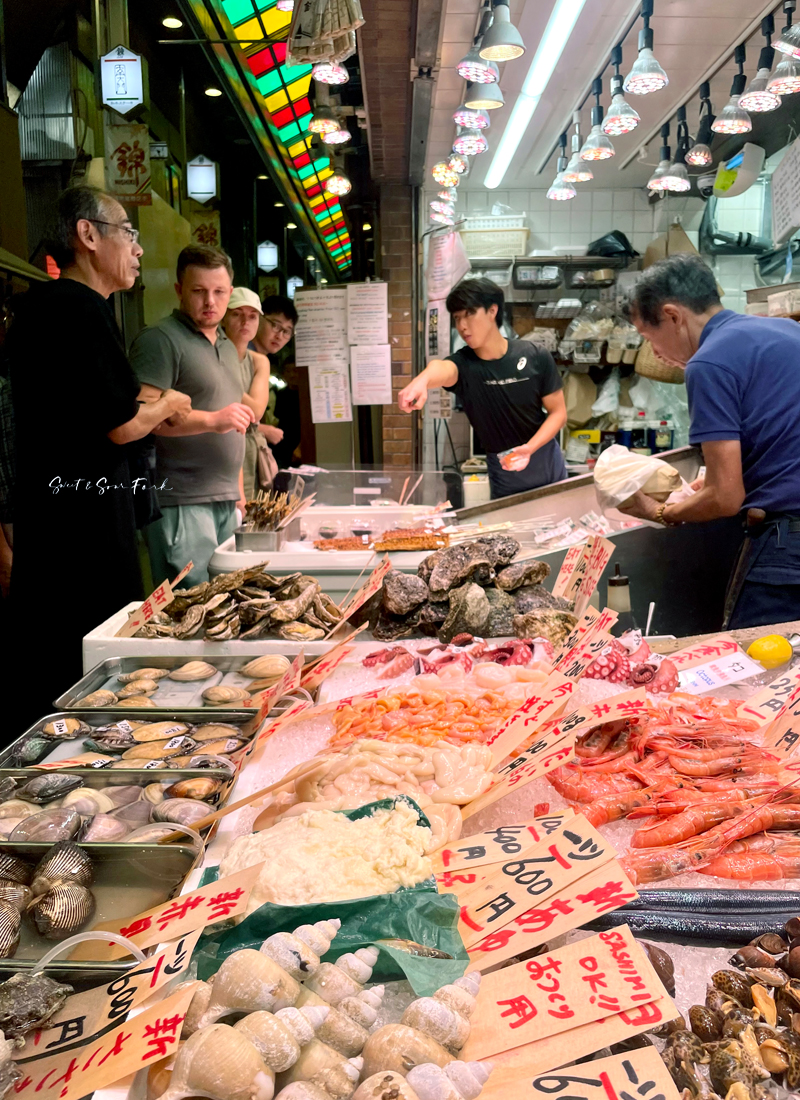
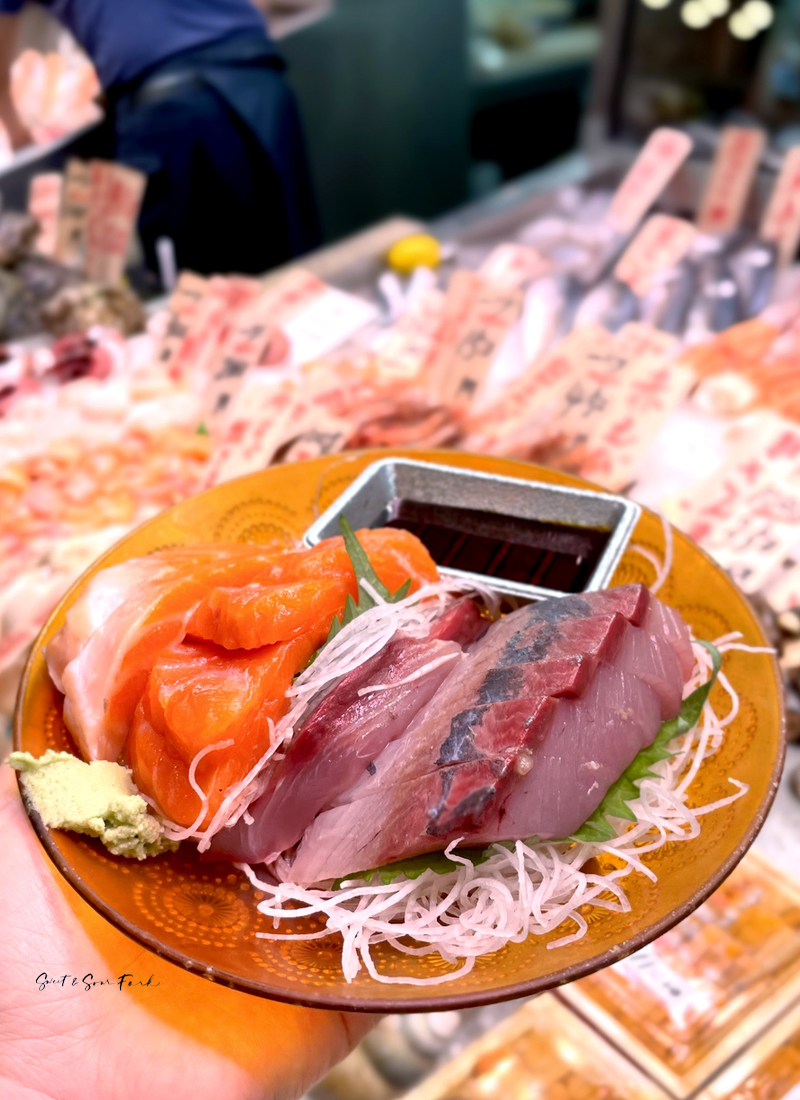
Yellowtail (300 yen, 7pcs)/Salmon (600 yen, 7pcs)
Fresh seafood abounds here, and whilst you can purchase it to go, the best thing to do is to perch yourself at one of the many tiny tables, and get some sashimi sliced up to order. Both the quality and quantity here is truly remarkable, and I feasted on thickly-sliced Yellowtail (300 yen, 7pcs) and Salmon (600 yen, 7pcs) for the kind of price that would normally barely net you a couple of hand rolls back at home. The Scallops (300 yen) are also a good order; the shellfish were so large you could get about 3 pieces from each.
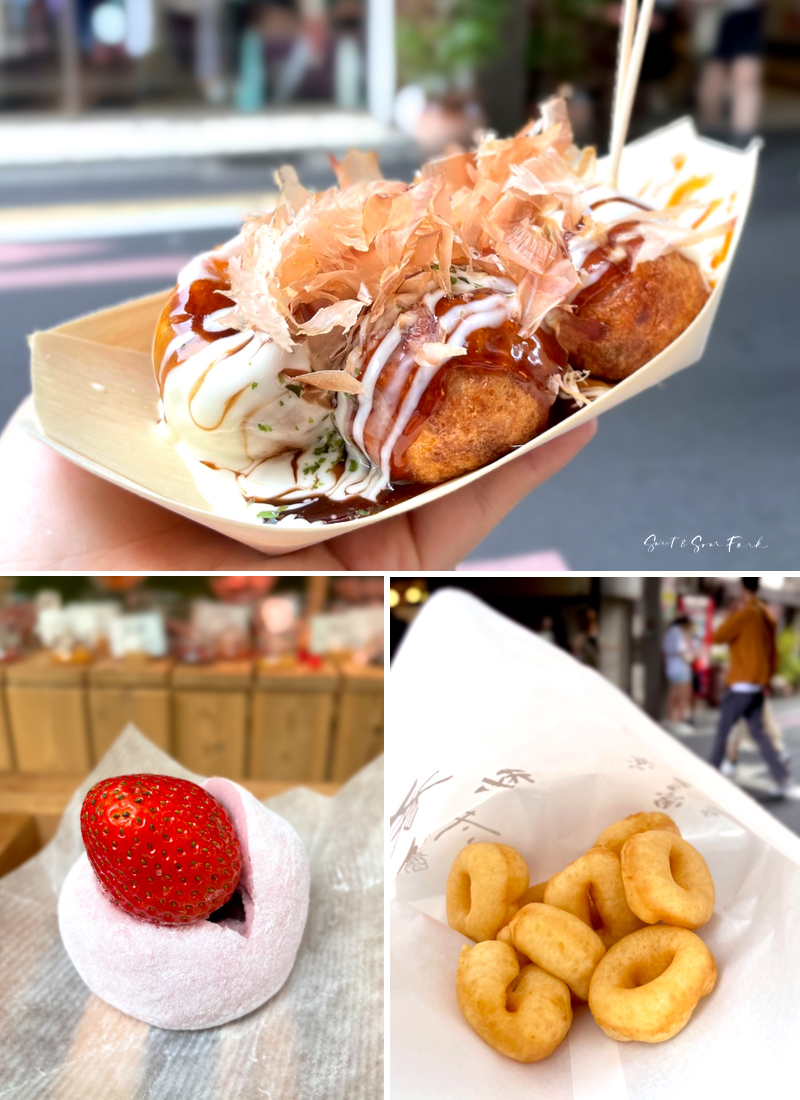
Takoyaki (500 yen, 4pcs)/Mochi with Strawberry (350 yen)/Soy Milk Donuts ($350 yen, 8pcs)
Takoyaki (500 yen, 4pcs) is the real deal here – enormous in size with an almost-liquid centre that comes gushing out at about 1000 degrees. I have had ones with slightly more flavoursome batter, and I do prefer a slightly tangier sauce, but these are objectively very good. The Mochi with Strawberry (350 yen) is what you’ll see all over Instagram, and it’s an easy crowd-pleaser of a chewy red-bean-filled mochi, stuffed with an incredibly juicy strawberry. As tempting as it may be to get 3-4 for yourself however, be warned that this is really heavy, and one to be cautious of if you’re keen on trying a lot of things at the market. One hidden gem not to miss is the Soy Milk Donuts ($350 yen, 8pcs). Made right in front of your eyes, these are super light and fluffy – almost sponge-cake-like in texture – and incredibly moreish.
Honkaku Teuchi Udon Taiga
7 Chome-45-1 Fukakusa Nishiuracho
Fushimi Ward, Kyoto, 612-0029
Went a little out of the way to try Honkaku Teuchi Udon Taiga, and let me tell you – it was SO worth it. This Michelin-recommended udon spot is tiny, but is just off the beaten path enough that you won’t have to wait for a table, as long as you show up outside of peak time. The service is also stellar, and it comes with thoughtful little touches such as iced tea and cold hand towels for those humid Japanese summers. Definitely make time to visit this place, because it is easily the best udon I’ve ever had.
Rating: 15/20 – perfect udon.
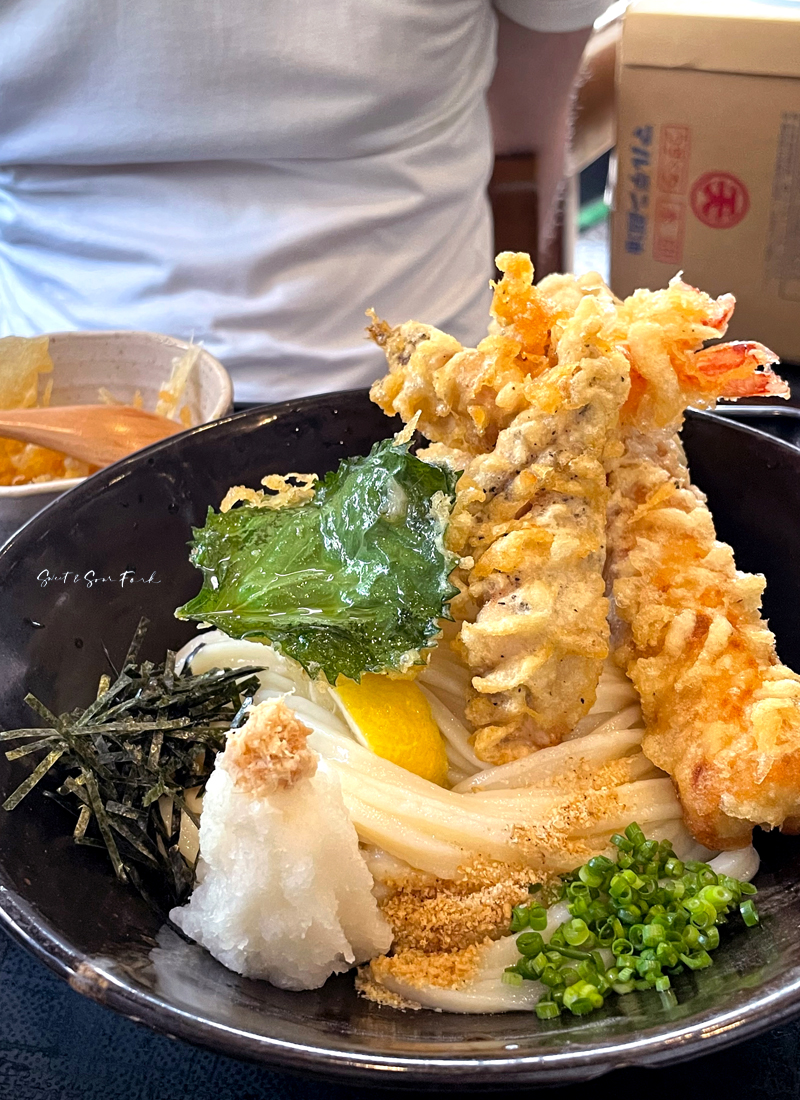
Okawamori Udon (1430 yen)
The Okawamori Udon (1430 yen) is utter perfection. Served cold, the amazingly chewy texture of the hand-made noodles really shines, whilst the chilled broth poured on top is super refreshing when mixed with the slightly bitter grated daikon. The accompanying tempura was also phenomenal, the perfectly light and crisp texture showcasing the quality of the ingredients. My favourite was the juicy piece of chicken, but you really can’t go wrong with any of it. You even get a bowl of tempura flakes on the side, so you keep that crispy goodness going with every bite.
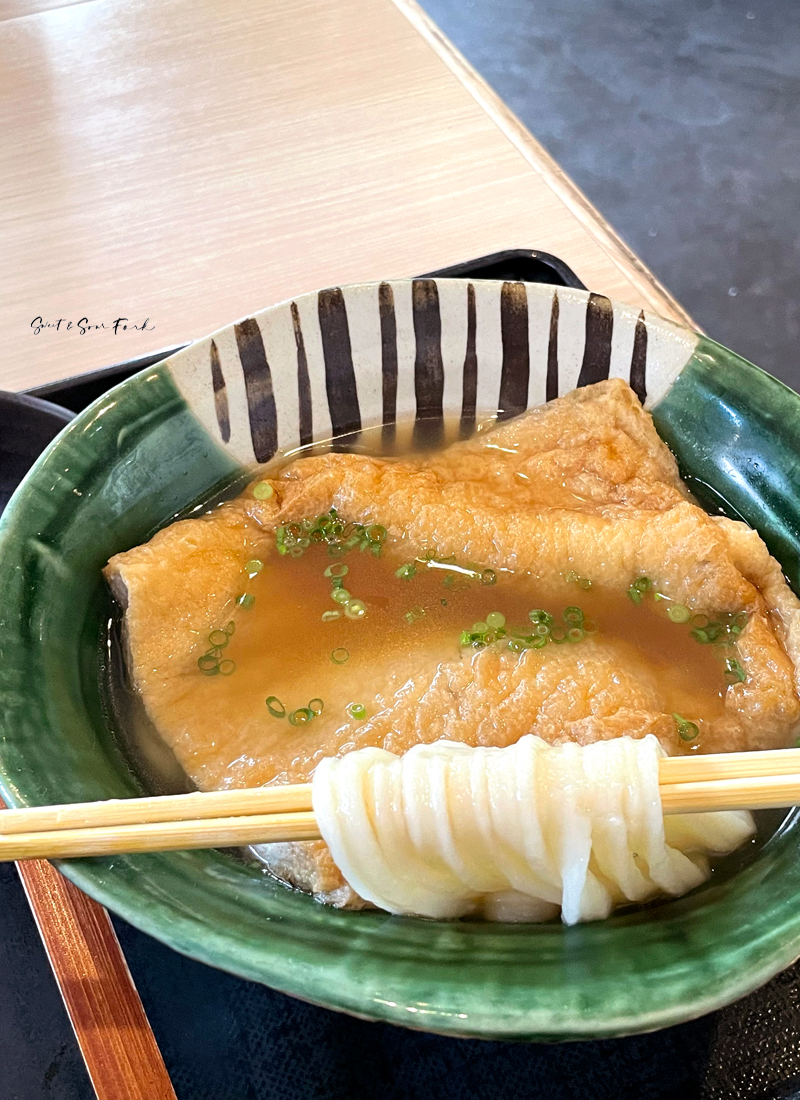
Kitsune Udon (1230 yen)
In comparison, I felt the hot Kitsune Udon (1230 yen) did a disservice to the texture of the noodles, as the warm broth naturally softens the udon. But that’s just personal preference, because this is still an amazing bowl. The soup was light and sweet (due to the lack of sardines), its flavour soaked up by the giant tofu puff on top, which was indeed ‘large volume’ as promised by the menu.
Izugen
391 Takeyacho Takakuradori Ayanokojisagaru
Shimogyo Ward, Kyoto, 600-8093
Izugen is another hidden gem in the heart of Kyoto, and a great place to try out Kyoto-styled sushi without breaking the bank. Run by an older couple, the hospitality here is second-to-none, and it was clear that many people who visited were locals and regulars. Saba-zushi is the specialty here – a nigiri-styled sushi made with cured mackerel and kombu – and the recipe they use has been passed down through 3 generations. If you’re keen on getting an authentic and local sushi experience, this is a must-do.
Rating: 14/20 – classic Kyoto sushi.
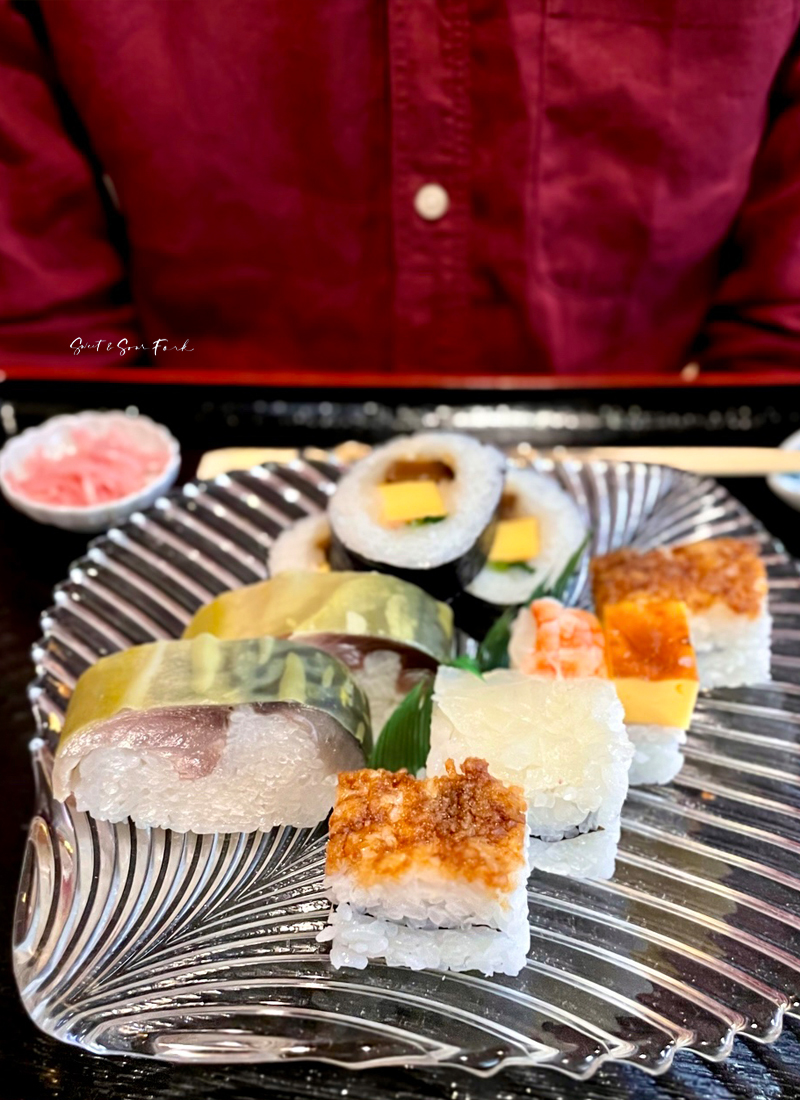
Kyozushi (1800 yen)
The Kyozushi (1800 yen) is the one to get if you want to sample all the classic items. First of all: the mackerel sushi is absolutely delicious. The light curing process takes away the bulk of the brininess, and what you’re left with is a rich and fatty fish, balanced out with a hint of vinegar, and the clean saltiness of kelp. This is also where the rice really shines. Instead of being mixed with sushi vinegar, it’s actually cooked in a barely-there dashi stock, and the resultant sweetness to the grains really mellows out the edges of the stronger flavours. Conversely, I was less impressed with the hako-zuzhi – the pressed box sushi. There was certainly nothing wrong with it, but I just found the scant toppings to be relatively bland.
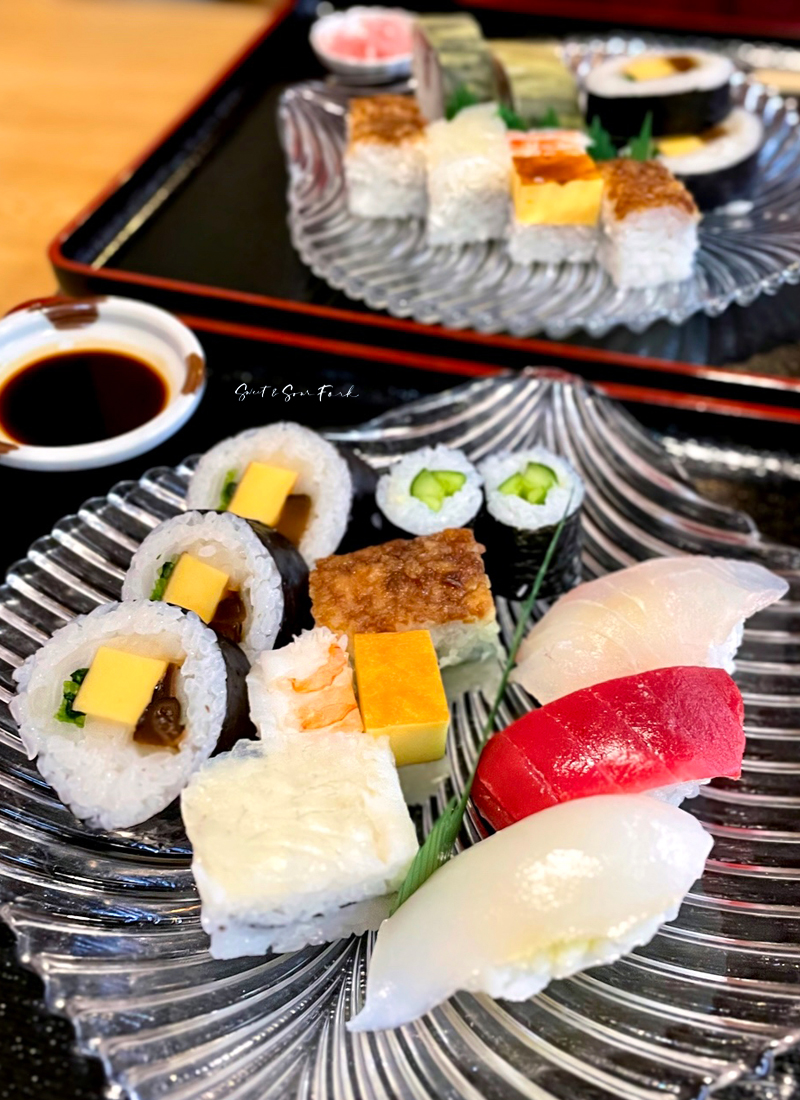
Moriwase (1800 yen)
I was a huge fan of the makizushi, which also comes in the Moriwase (1800 yen) set. This doesn’t actually have any seafood in it; instead, it’s filled with a humble but nourishing combination of egg, burdock root, and seaweed. The nigiri-zushi were also top-notch, made with the freshest seafood of the day. Even the cucumber rolls were extra tasty, the crisp cucumber enhanced by a tiny smear of wasabi.

Inari (400 yen)
I heard good things about the Inari (400 yen), and I gotta say – this stuff is miles away from what you get at your usual takeaway shop. The tofu has a delicious sweet-savoury flavour, complimenting the nutty sesame seeds mixed through with the rice.
Ichiran Ramen
102-3 2F Tachiuri Nakanocho
Shimogyo Ward, Kyoto, 600-8006
https://en.ichiran.com/index.php
Ichiran is famous world-over, and they’re so successful they’ve even created and released a packaged version of their ramen, so you can have the goods anytime, anywhere. But does it live up to the hype? Sort of yes, and sort of no. It was definitely a delicious bowl of Hakata-styled noodles, and the ability to customise nearly every feature is a win. It does however lack both the soul and flair of a high quality, independently run ramen-ya, even if you can’t fault them for consistency. Chris had no qualms; he was just upset we couldn’t fit in a second visit. And I will admit: though not anything special by Japan standards, I can see myself coming here if I just want a quick, tasty bowl of tonkotsu ramen without any of the fuss.
Rating: 13/20 – instant ramen, japan style.
How neat! The restaurant shows off noodle order sheets from different famous people over the years, so you can look for your celebrity ramen soulmate whilst waiting in line!
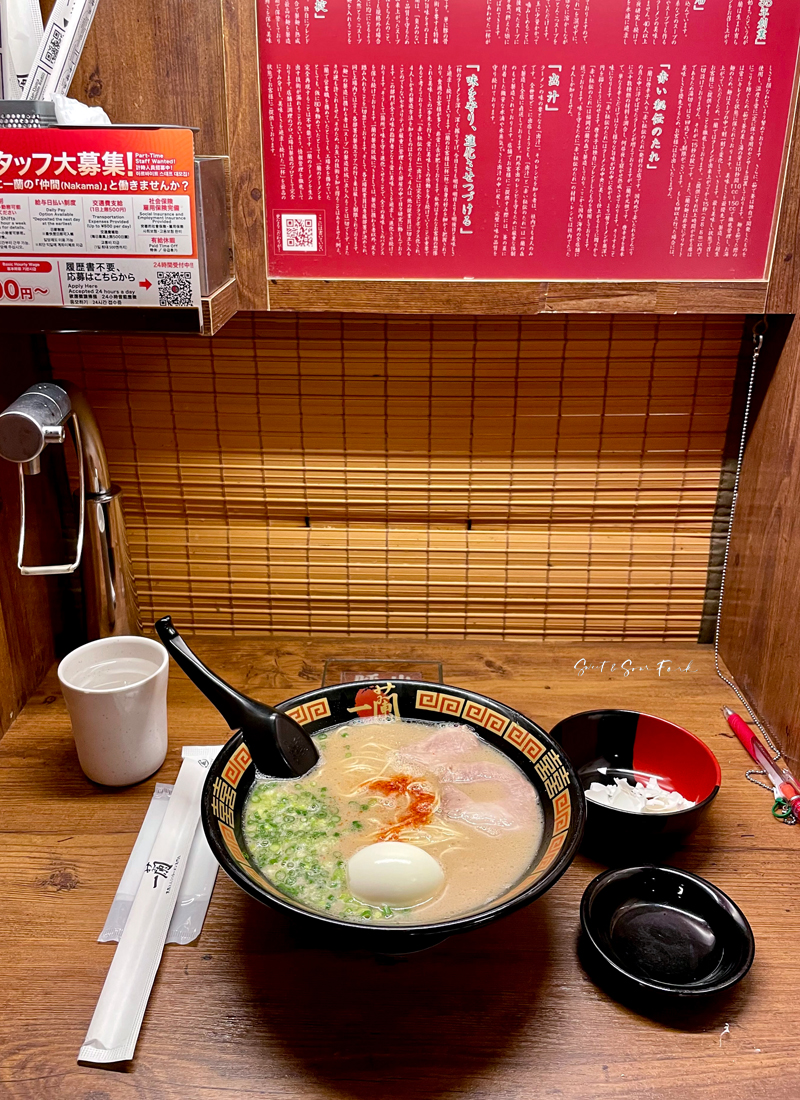
Original Ramen (890 yen) with Egg (140 yen)
Look! It’s the famous Ichiran booth! Some might argue it’s antisocial (and it totally is), but in Japan, a ramen-ya is absolutely not the place to linger with your friends for a chat. So slurp your ramen (that on the other hand is NOT considered rude) and get going!
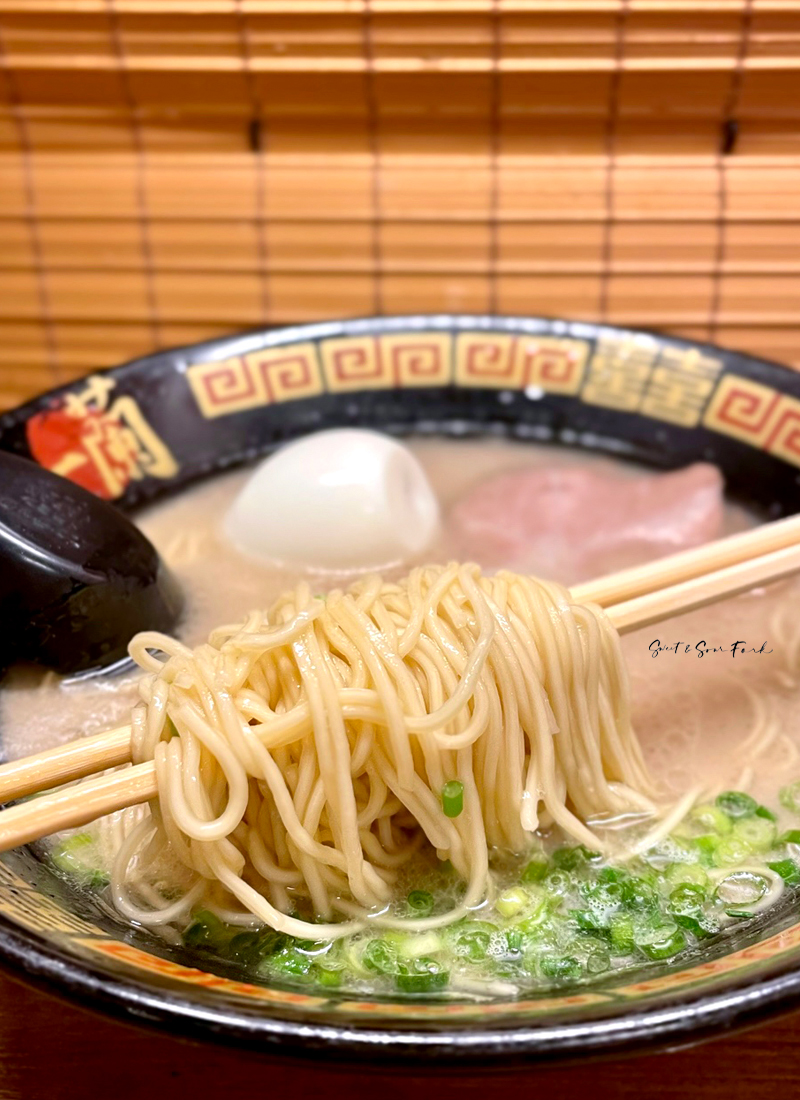
Original Ramen (890 yen) with Egg (140 yen)
Anyway, most of the noodles here are some variation of the Original Ramen (890 yen) with Egg (140 yen). And say what you will about it being overhyped – it’s still a tasty bowl of noodles. The soup is a great balance between savoury and creamy, though you can definitely pump up the luxuriousness of the mouthfeel by asking for a richer soup with more garlic. I on the other hand preferred the slightly less fatty soup, which really allowed the porky flavours to shine. Where this bowl fell down was the toppings; not only did you have to pay extra for most items, the egg was a touch overcooked, and the charshu on the dry and tough side. As for their famous chilli? I’m pretty indifferent. It’s a dry and smoky-styled sauce, whereas I tend to prefer an earthier flavour. For the spice-heads out there however, you can get up to 20 chillies or something ridiculous like that, if you don’t want to feel your face (but really want to feel another part of your body) for the rest of the week.
Saga Tofu Ine
19 Sagatenryuji Tsukurimichicho
Ukyo Ward, Kyoto, 616-8384
https://www.kyo-ine.com/en/tofu/
The bamboo grove of Arashiyama is world-famous, but did you know the town is also known for their tofu? And if you dodge Saga Tofu Ine because you think you don’t like tofu, then you’re doing yourself a huge disservice. The combination of freshness and quality makes this unlike any tofu you’ll get elsewhere, and it’s served in the most elegant and beautiful ways. This may not be as iconic as the bamboo grove, but honestly? I think if you had to pick one, this is the more worthwhile activity. After all, it’s not everyday I eat the best tofu I’ve ever had.
Rating: 15/20 – if you don’t like tofu, this is the final testing ground.
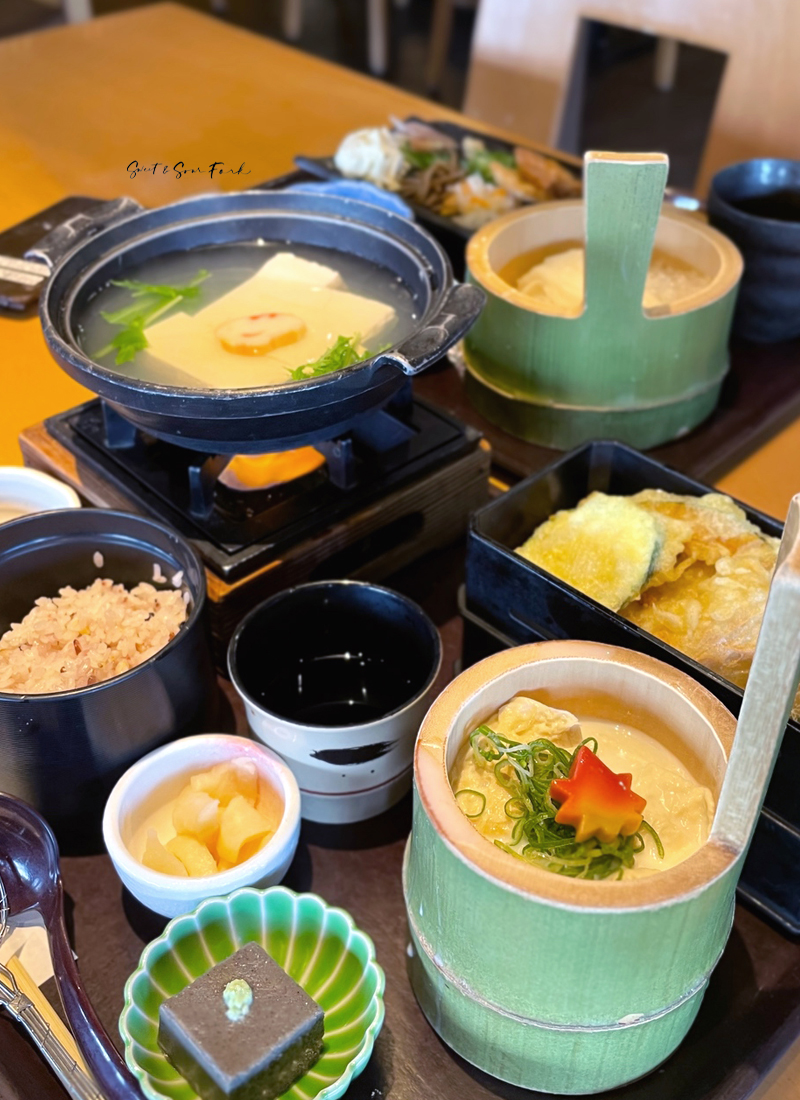
Vegetarian Set (2180 yen)
The Vegetarian Set (2180 yen) is one of the more elaborate sets on offer, and it is the most exquisite Japanese-styled feast for one. Pride of place goes to the delicate boiled tofu, which has the most amazingly creamy flavour and mouthfeel, almost akin to a flan. Despite how light it was, the texture made eating it feel almost decadent. My favourite however would be the tofu skin, served in a little bamboo crock. It came with a crisp, tangy dipping sauce, but I was perfectly enamoured with just the delicate sweetness and slightly toothsome texture of the tofu sheets. Among the other bits and bobs, the pickles were an unexpected highlight, and were such a simple pleasure eaten with the fluffy rice. The only disappointment was the tempura, which was limp and greasy. But it was made up for by the little desserts that came hidden in the box underneath.
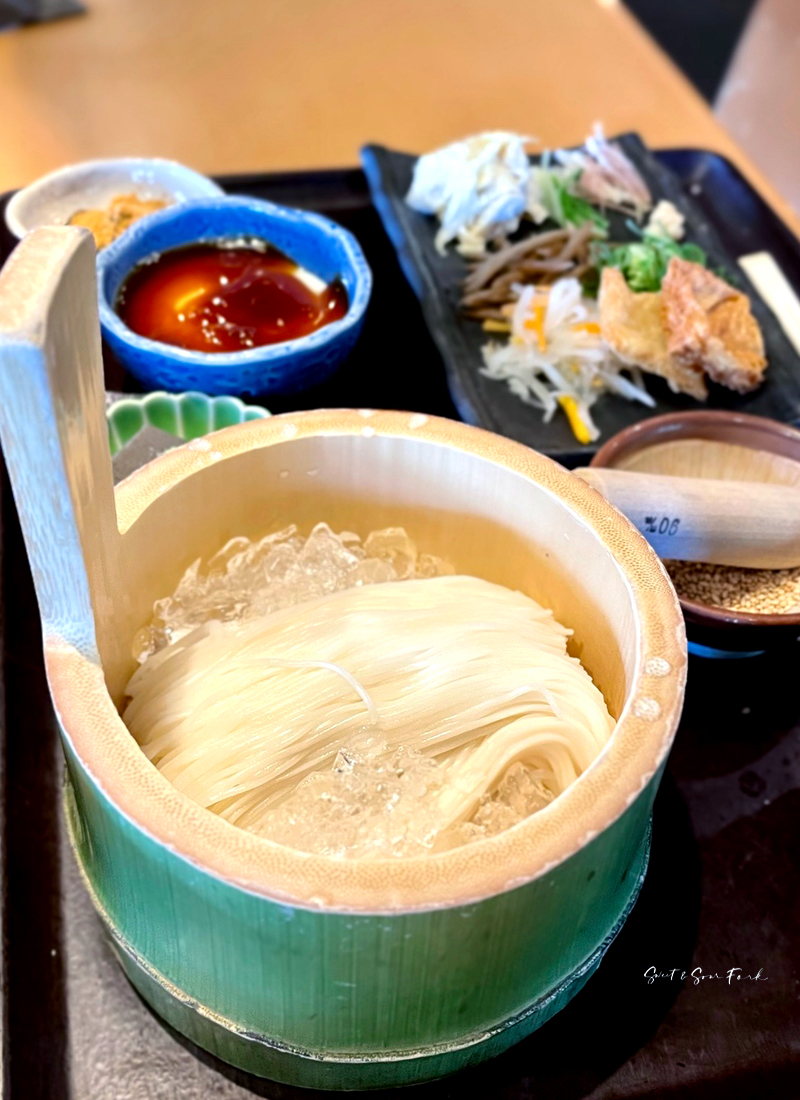
Somen Noodle Set (1600 yen)
There was a summer special of Somen Noodle Set (1600 yen) when we visited, and having only ever heard of it before, I was eager to try, and proceeded to have my mind completely blown. Being another cold noodle, you’d think it wouldn’t be all that different from soba. In reality, the two are night and day, and it all comes down to texture. Instead of the rustic earthiness of soba, this was the cool slipperiness of vermicelli, but with the added body and nuttiness of wheat-based noodles. Served icy cold, this was intensely refreshing, and I savoured every rapidly-disappearing bite. Yes the accompanying dishes were good too, but the MVP was clearly the somen. The only other thing I will say is, make sure you grind up some sesame seeds with the mortar and pestle, then sprinkle it into your dipping sauce – it adds the most miraculously nutty aroma to the light, gingery stock.
Chanponteiso Honkeshijokarasumaten
715 Yakushimaecho
Shimogyo Ward, Kyoto, 600-8416
Chanponteiso Honkeshijokarasumaten is just down the road from our hotel, and after walking past it multiple times, we decided to step in for dinner. After all, it looked good and smelt excellent, so why not? This is the kind of place on every street corner in Japan that just makes me fall even more in love with the country. It’s so quaint and rustic, and whilst the food may not win any awards, it’s so obviously made with love and care and frankly, is nothing short of delicious. There’s just nothing like listening to the hiss of soup splashing into the wok, followed by the smoky, aromatic sizzling that you know is going to end up in front of you within minutes.
Rating: 13/20 – family good times.
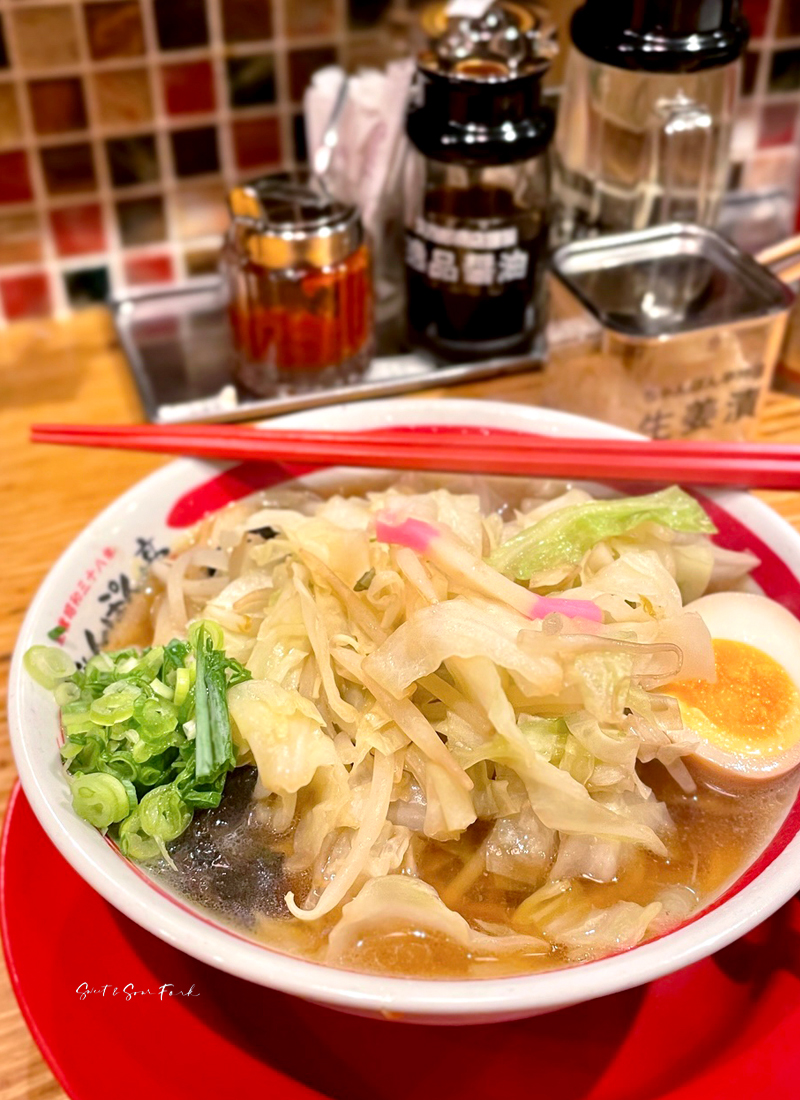
Vegetable Champon (1050 yen)
The name gives it away slightly, but the specialty here is champon – a comfort dish that’s a halfway between stir fry and ramen, where the soup gets dumped straight into the hot wok along with the noodles. The Vegetable Champon (1050 yen) is a hearty mess of cabbage, thick noodles, sliced pork, and fish balls in a light, sweet pork soup. It’s just what’s needed after a long day of walking and not eating greens.
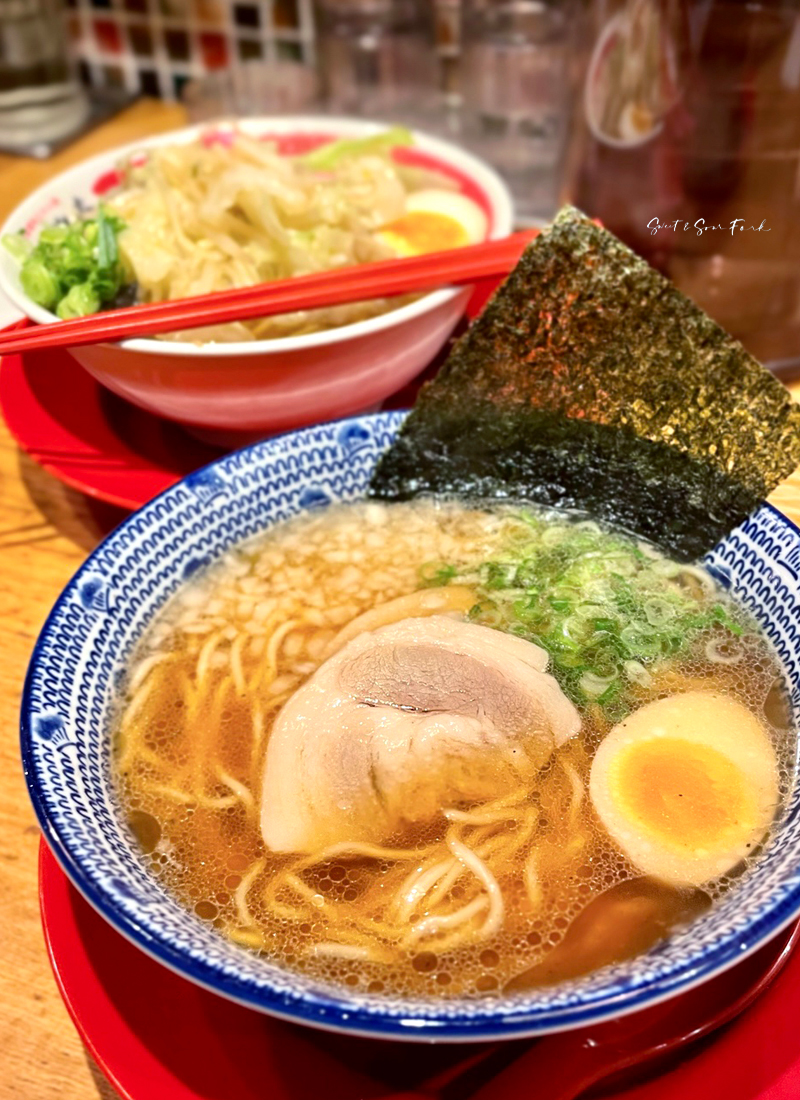
Special Ramen (950 yen)
Whilst we were here, we also tried out the Special Ramen (950 yen). Even though this is not a specialty ramen-ya, this was surprisingly excellent. The soup is a super umami blend of pork and chicken, and the noodles were thick and chewy with a great alkalinity. The egg was a bit on the bland side, but the charshu was mega fatty and flavoursome.
Sushi No Musashi
8-3 Higashishiokojitakakuracho, Shimogyoku Kyoto Omotenashi Komichi
Kyoto Station 8jo Entrance, Kyoto, 600-8214
I was after a quick sushi meal one evening, and Sushi No Musashi in Kyoto station seemed as good as any; at any rate it was popular and had a good mix of tourists and non-tourists, so you’re at least guaranteed good turnover. Whilst not the most amazing sushi out there, it was an easy place for a quick bite, had a wide range of options, and the complimentary teabags and hot water taps at the tables were a nice touch. But mind you, maybe I’m just a little jaded after all the amazing seafood I’ve always had easy access to in Australia; the newlywed couple next to us (who were super cool by the way) from New York were in absolute raptures from every plate. Apparently back home, it costs twice as much to get sushi about half as good. So yeah, call this one slightly spoiled by my privilege.
Rating: 12.5/20 – perfectly reasonable sushi (and that’s by japan standards)
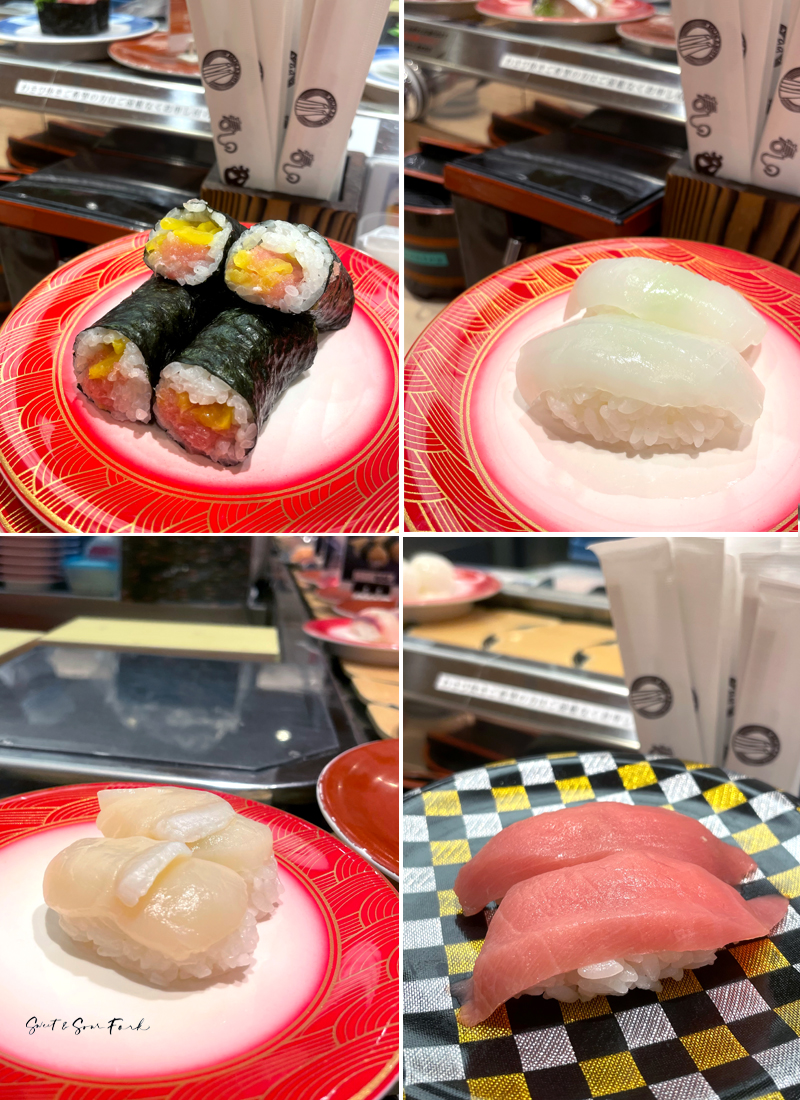
Tuna Daikon Hand Rolls (257 yen)/Raw Squid (257 yen)/Raw Scallop (257 yen)/Middle Blue Fin Tuna (697 yen
If you do find yourself at Sushi No Musashi, the ones to order are as follows: the Raw Scallop (257 yen), which was sweet and silky; the Raw Squid (257 yen), which was fresh, firm, and just a little sticky; the Tuna Daikon Hand Rolls (257 yen), where the creamy fish contrasted really well against the salty crispy daikon, and made for a delicious little parcel wrapped in rice and nori; and the Middle Blue Fin Tuna (697 yen), which was unsurprisingly super buttery and decadent, and an easy way to get a bit of indulgence in on a budget. Also just be aware – like at most places in Japan, the sushi comes pre-wasabi-ed. Given that they use the real stuff though, and the fact that they only use a tiny bit, I think it does what it’s supposed to and enhances the flavour. If you’re sensitive to spice however, or god forbid, have an allergy, then make sure you take note.
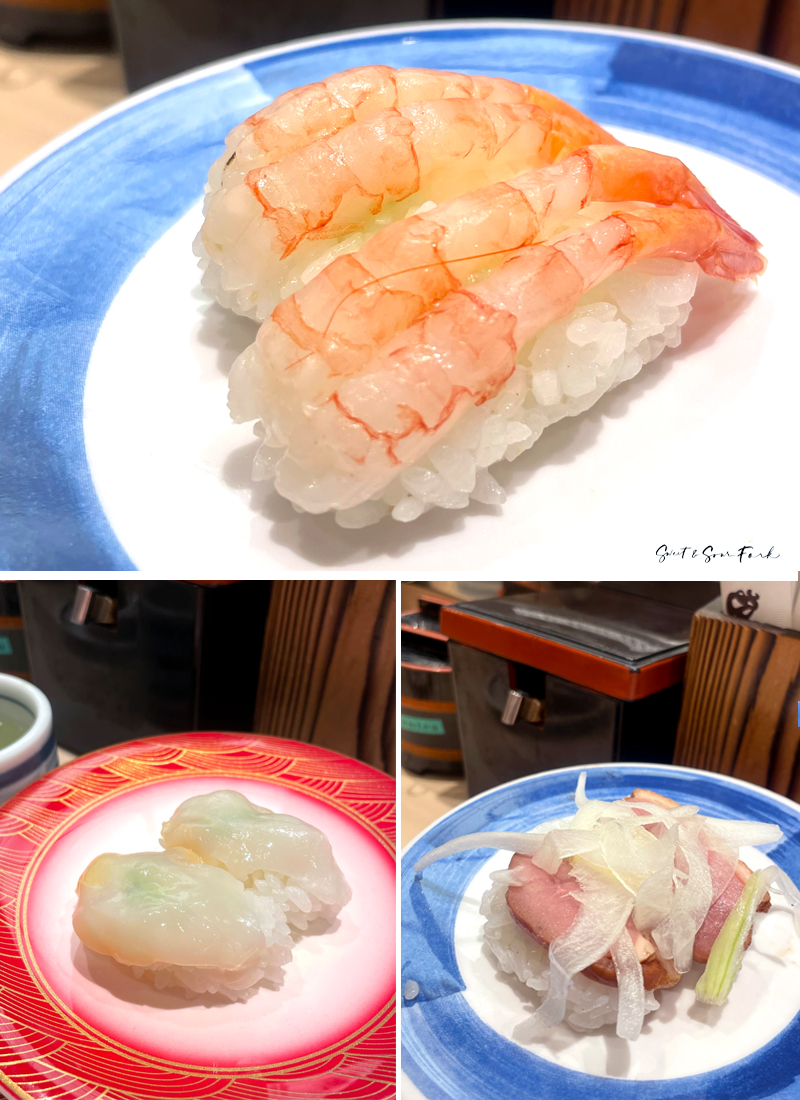
Sweet Prawn (160 yen)/Whelk (257 yen)/Smoked Duck (160 yen)
Not as amazing, but still worth getting are the lovely and crisp Whelk (257 yen), delicate Sweet Prawn (160 yen), and weirdly enough, the Smoked Duck (160 yen).
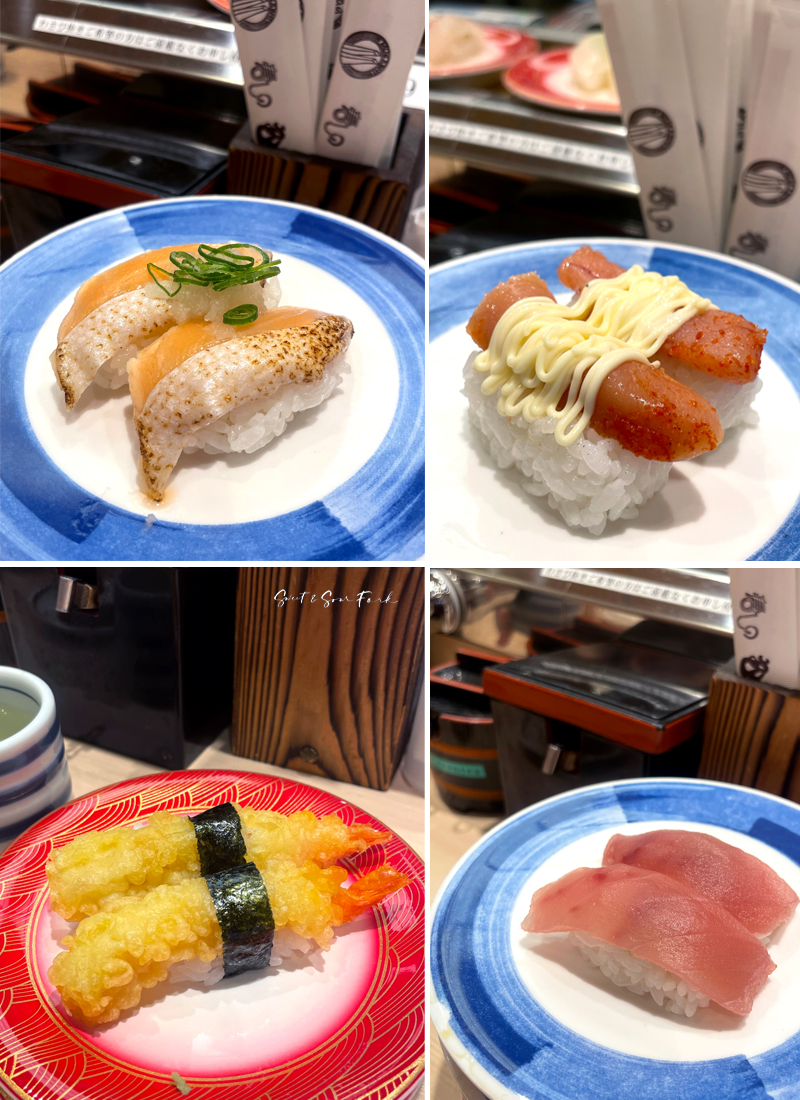
Grilled Salmon (160 yen)/Mayo and Cod Roe (160 yen)/Prawn Tempura (257 yen)/Albacore Tuna (257 yen)/
Don’t get these though; they’re average at best – Albacore Tuna (257 yen), Grilled Salmon (160 yen) – and kinda gross at worst – Prawn Tempura (257 yen), Mayo and Cod Roe (160 yen).
Yoshinoya
https://www.yoshinoya.com/en/
If you spend more than about 10 minutes in Japan, you’ll come across Yoshinoya – a ubiquitous fast food chain dealing in gyudon (beef bowls), but also a variety of other simple home-styled Japanese dishes. It’s not the best food but by god, is it cheap and convenient. And with this being Japan at all, the food is perfectly on par with what you’d pay for in a standard Japanese restaurant back in Australia, if not even a bit better. If you’ve just stepped foot in Japan and are feeling intimidated, this is a great place to ease in with your floatie.
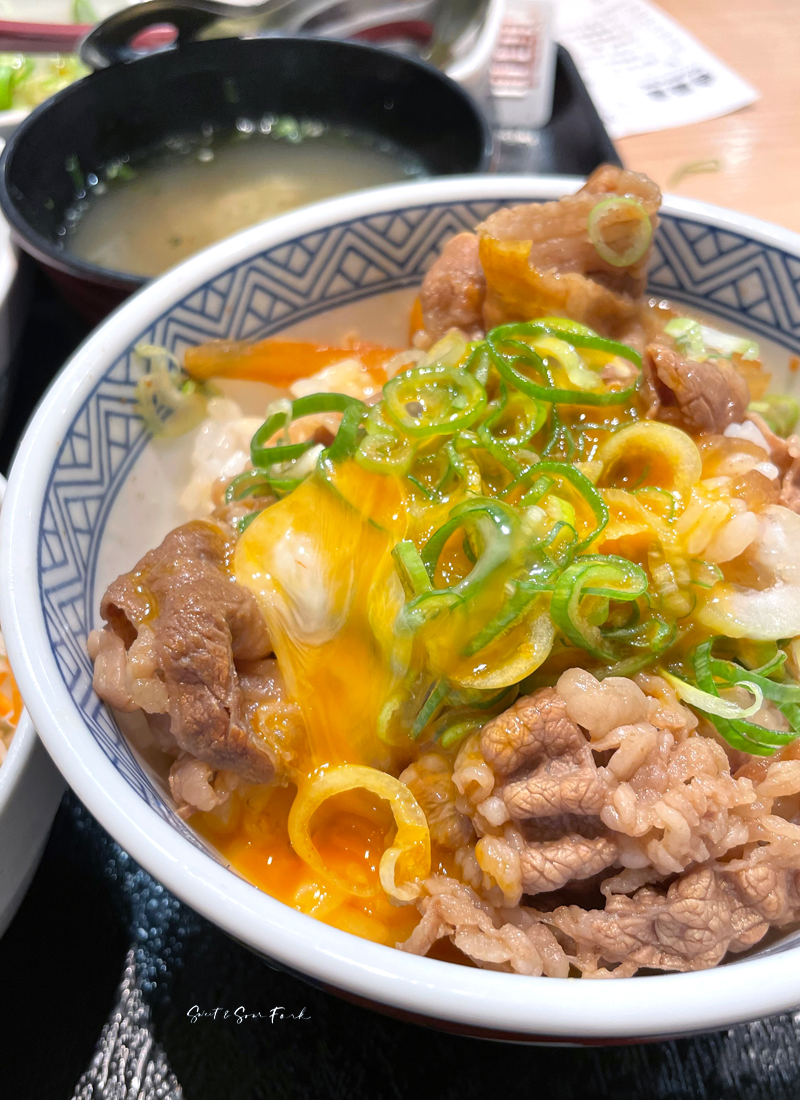
Gyudon (599 yen, regular) with Miso Soup and Salad (206 yen)
But back to the Gyudon (599 yen, regular), which I got in a set with Miso Soup and Salad (206 yen). This is exactly what it promised on the package – thin slices of beef, cooked in a sweet soy sauce, served with a raw egg yolk for dipping. It’s peak comfort food, especially once you get down to the grains of rice covered in yolk and meat juices. The miso soup and salad were very ordinary, but we all know how I feel about vegetables by now.
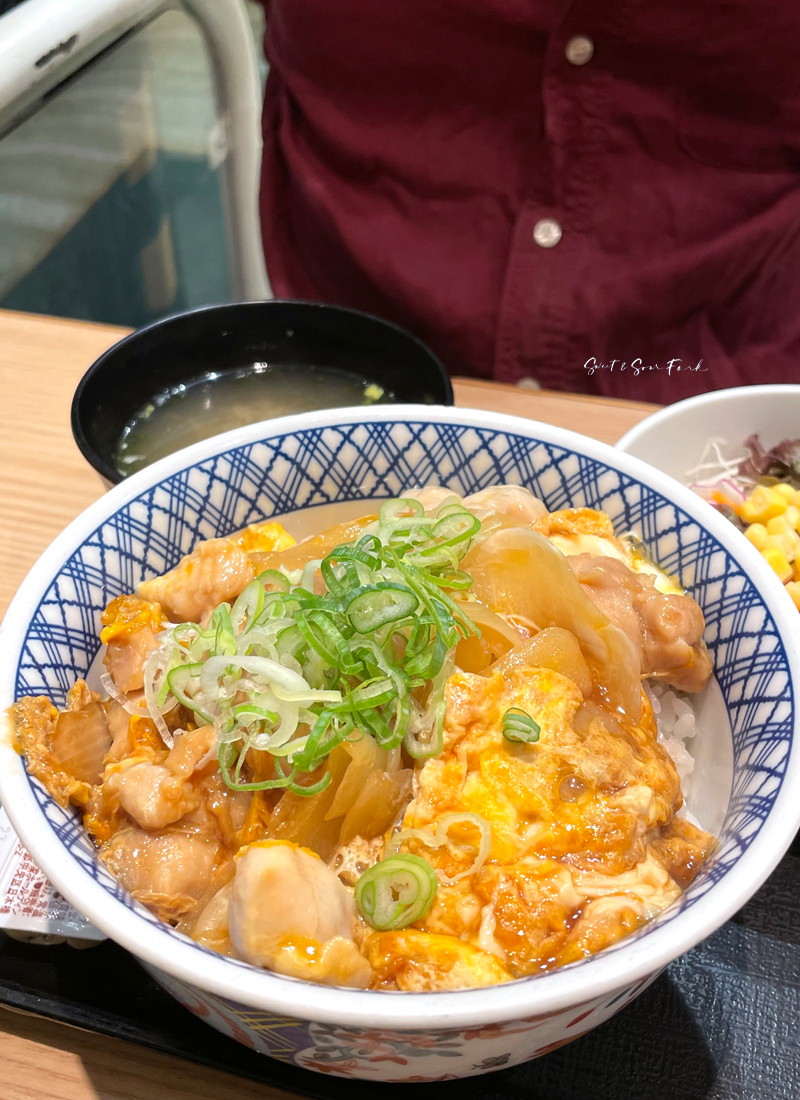
Oyako Don (734 yen, large)
The Oyako Don (734 yen, large) is another common comfort dish, consisting of pieces of tender chicken cooked with egg into a sort of soft omelette, along with sweet onions and a mellow sauce.
Matsuya
https://www.matsuyafoods.co.jp/english/
Matsuya is the main competitor to Yoshinoya, and whilst it has similar offerings at a similar price point, it does also have some dishes the other doesn’t have (and vice versa). Which is better is almost certainly down to personal preference – I’m a Yoshinoya fan as that’s what I ate at when I first came to Japan 10 years ago, whilst my parents prefer Matsuya for the same reason. Chris meanwhile is in camp Matsuya, simply because he happened to have an upset tummy when we ate at Yoshinoya (important distinction – WHEN we ate there, not BECAUSE we ate there).
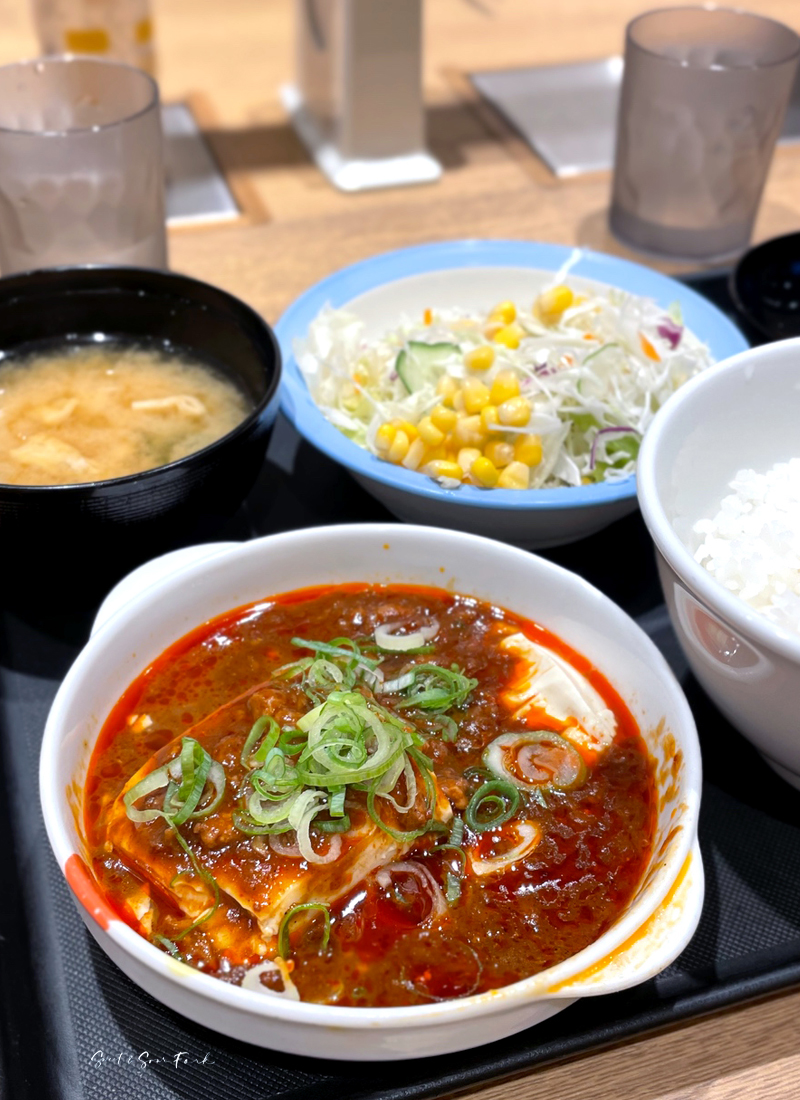
Mapo Tofu Set Meal (590 yen)
The Mapo Tofu Set Meal (590 yen) was amazing value. For less than $7 AUD, you get a dish of jiggly mapo tofu, a bowl of rice, as well as a salad and miso soup. This honestly surprised me with how good it was. Although the tofu is a touch on the sweeter side, it had a good deal of richness and spiciness, as well as the characteristic numbing quality that’s so important to this dish. I would honestly have been happy if my local Chinese eatery at home could make a mapo tofu this good. The miso soup was also leaps and bounds better than the one at Yoshinoya, though I do wonder if there’s some degree of variation between shops from the same chain.
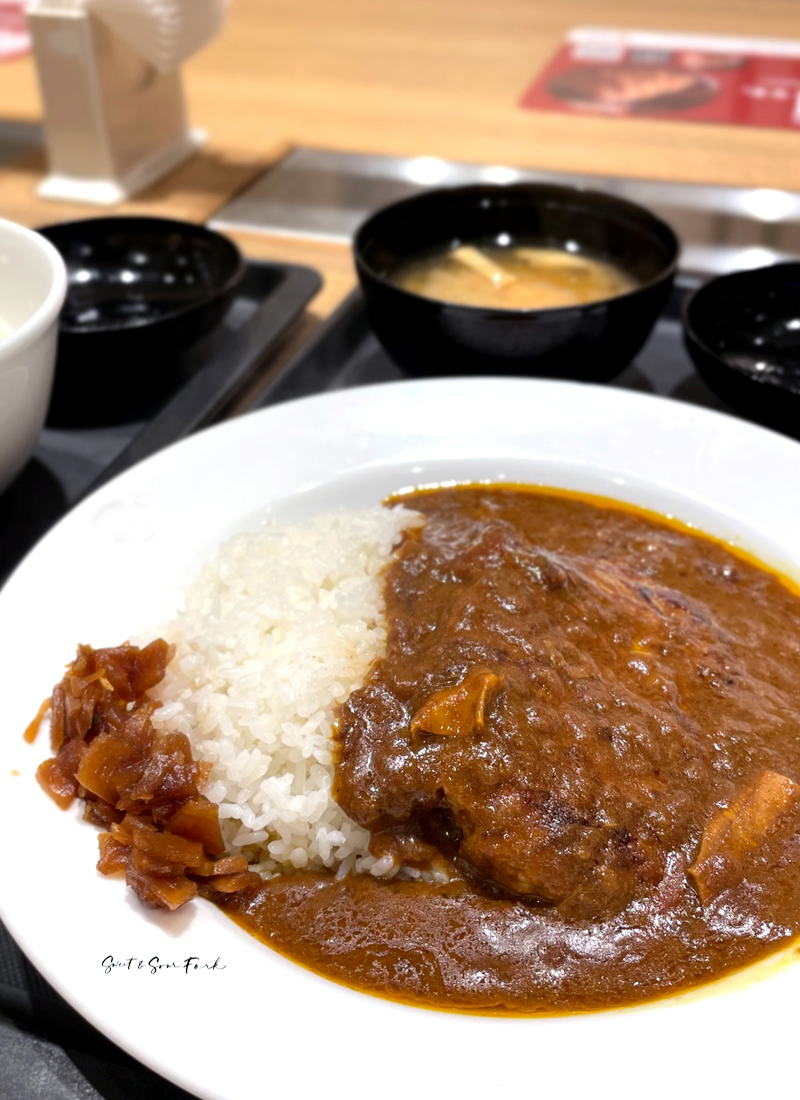
Hamburger Steak Curry (830 yen)
The Hamburger Steak Curry (830 yen) was also a hit. Though slightly on the saltier side, and obviously not as deeply flavoured as those from dedicated curry houses, this was still a really great plate of curry, and the portion size left no room for complaints.
Other Kyoto Yummies
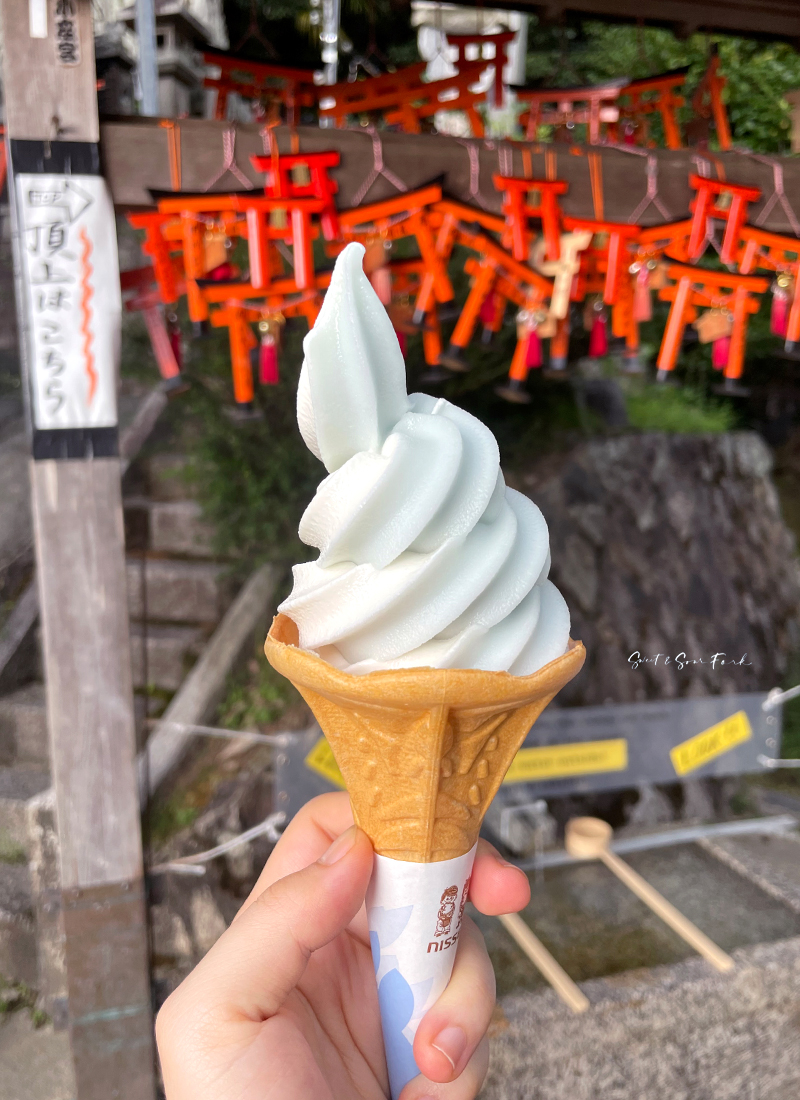
Lemonade And Vanilla Soft Serve (450 yen)
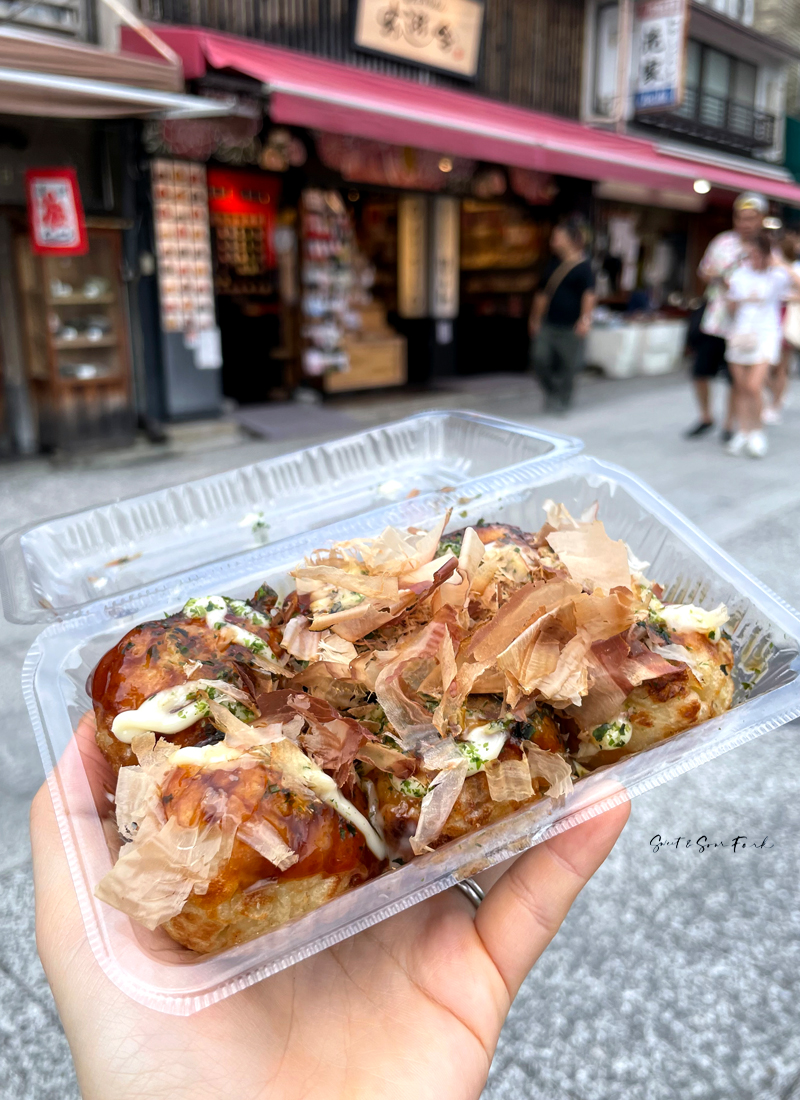
Takoyaki (400 yen, 6pcs)
One good thing about Fushimi Inari shine becoming such a tourist hotspot is all the street food that has cropped up in its wake. The Lemonade And Vanilla Soft Serve (450 yen) was pricy, but very refreshing after the sweaty climb, and tasted like an ice cream spider! The Takoyaki (400 yen, 6pcs) were a bit gluggy after having sat in the grill for a bit too long, but at least they were cheap!
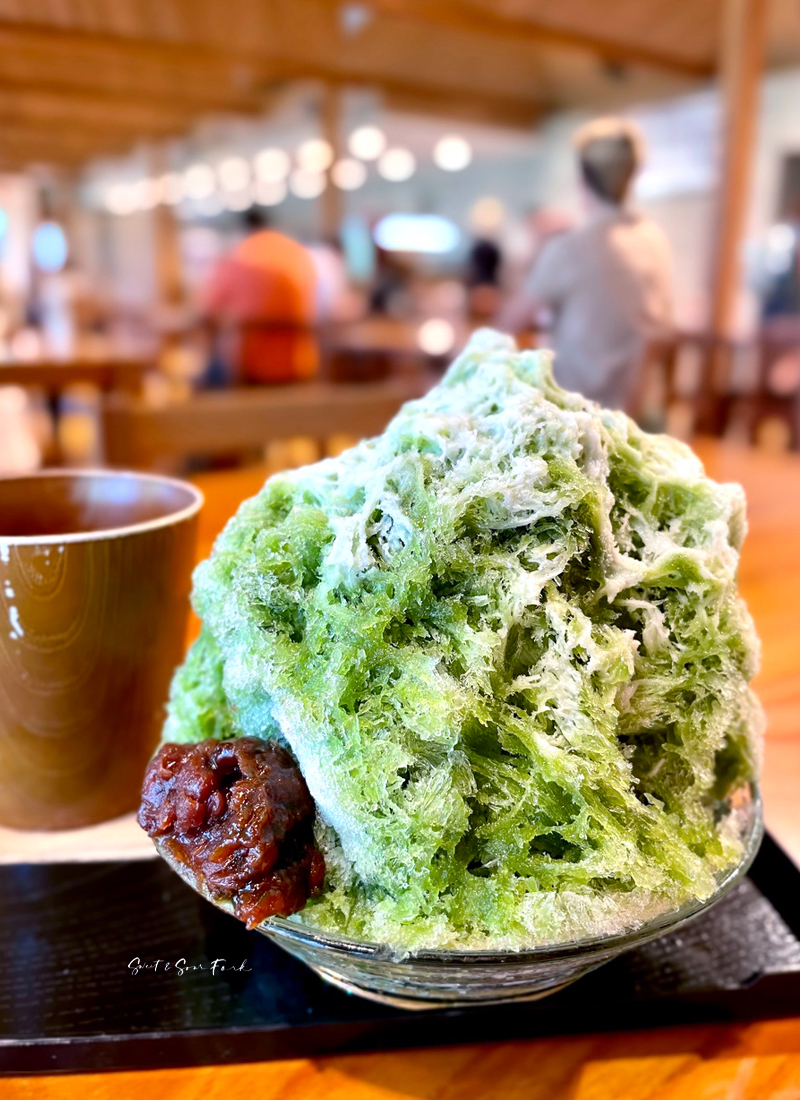
Uji Matcha Milk Shaved Ice (670 yen)
The Kyoto Imperial Palace is worth a visit, but there is so little shade that you’re bound to end up completely parched on a hot day. Enter the Uji Matcha Milk Shaved Ice (670 yen) at the palace café – an avalanche of feathery ice crystals, carefully drizzled with a refreshingly bitter matcha syrup, and sweetened with evaporated milk, and a scoopful of jammy red bean paste. Probably the best shaved ice dessert I’ve had on this trip.
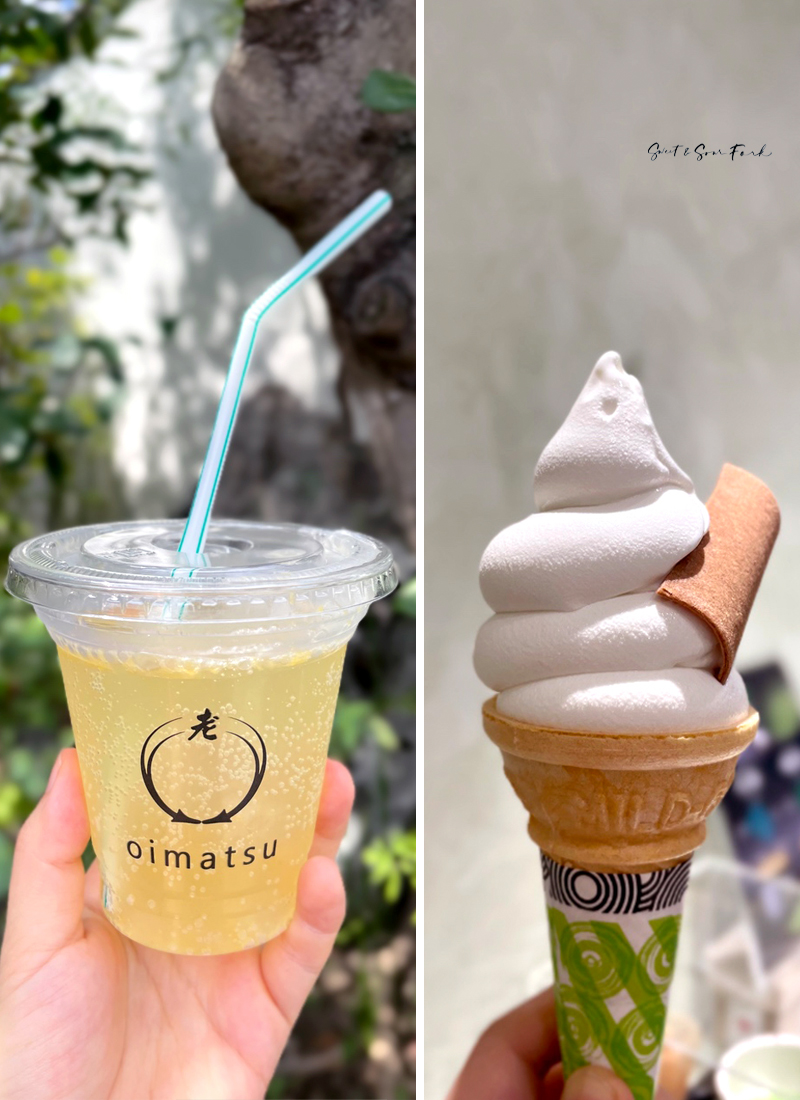
Natsumikan Soda (400 yen)/Soymilk Soft Serve (400 yen)
Lunch at Ine was the highlight of my Arashiyama trip, but I also managed to fit in a couple more neat little snacks. The Natsumikan Soda (400 yen) is a local specialty; made with a citrus fruit related to the pomelo, this boasted both a honey-like sweetness, as well as a refreshing tartness. And continuing along the tofu route, there was a Soymilk Soft Serve (400 yen), with a beguilingly delicate aroma and a super smooth texture.
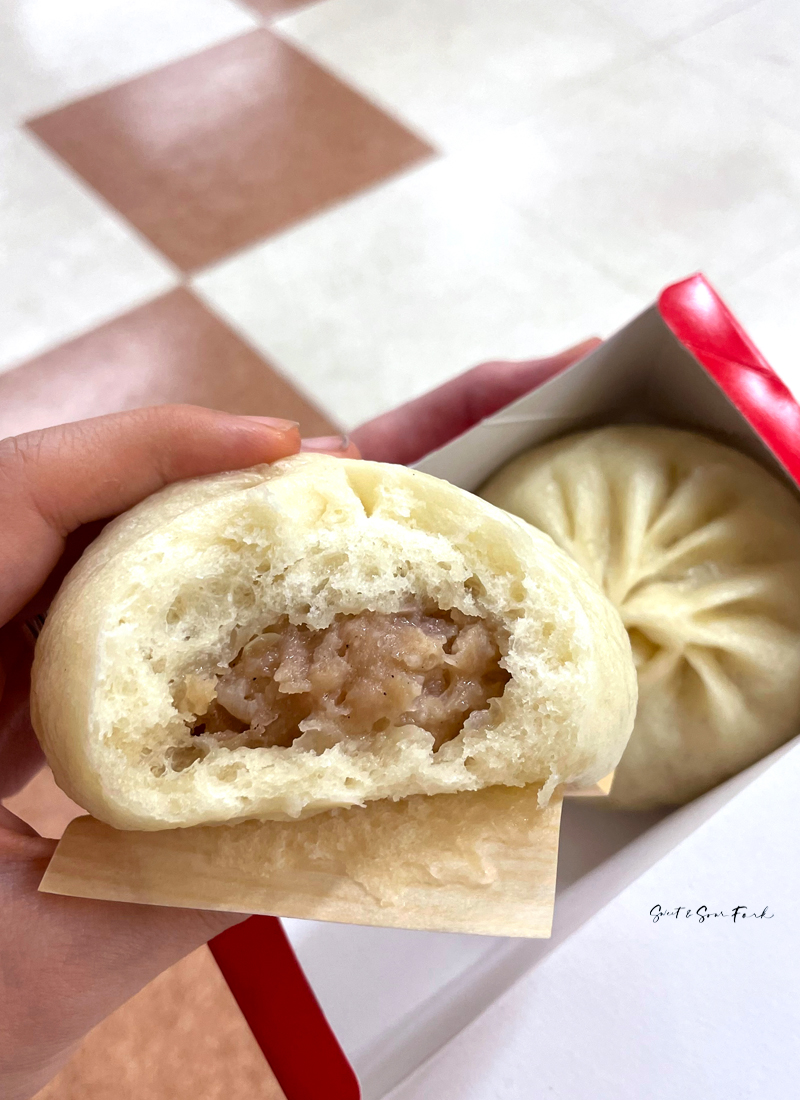
Pork Buns (420 yen, 2pcs)
I wasn’t going to try 551 Horai initially. Though a well-known place for pork buns and siu mai, I really wasn’t interested in lining up for half an hour in Osaka when we could get perfectly good pork buns at home. But then I happen to just run across a branch with no line, and thought: why the hell not? And these are indeed very nice Pork Buns (420 yen, 2pcs), with a really light, fluffy dough and a rich, onion-heavy centre. But would I line up more than a couple minutes for them? Absolutely not. Also; what is with the Japanese infatuation with obscenely pungent mustard? Don’t do what I did, and smear most of the packet onto a single mouthful.
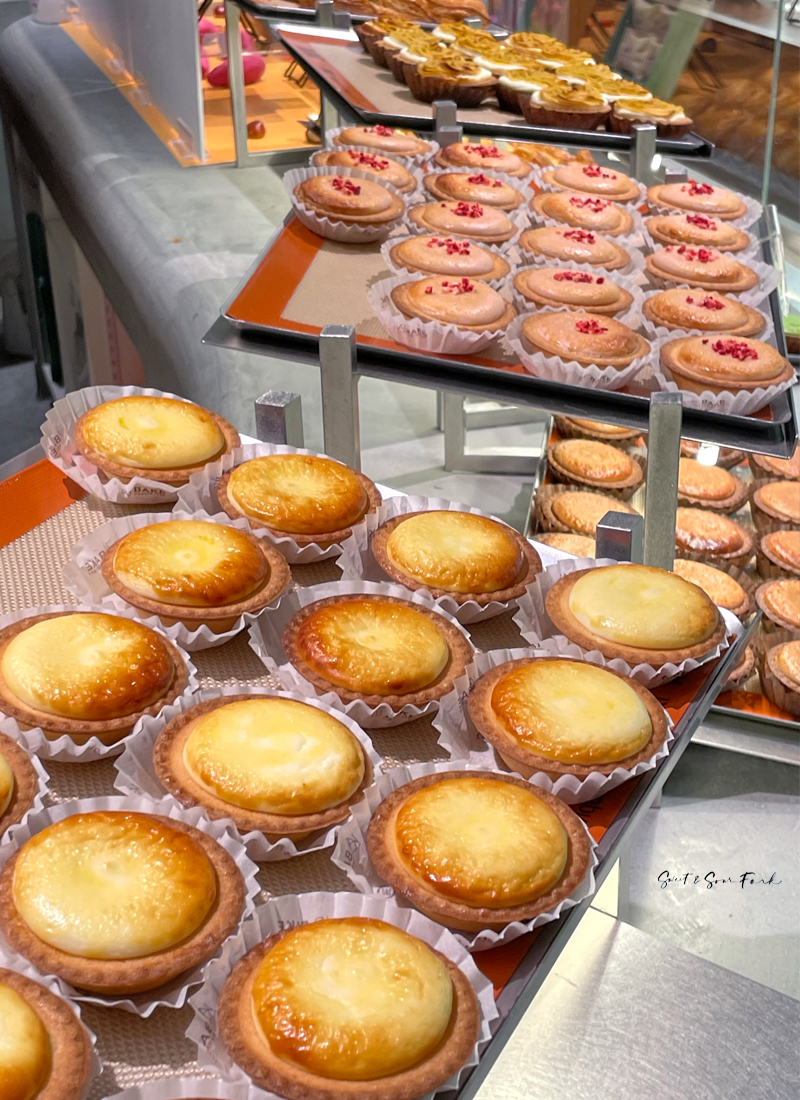
Cheese Tart (250 yen)
I’ve said it before, and I’ll say it again – the Cheese Tart (250 yen) at BAKE is top tier. I was obsessed with them when I first came across them in Korea, and I will continue to be obsessed with them until they see their way to opening in Australia.

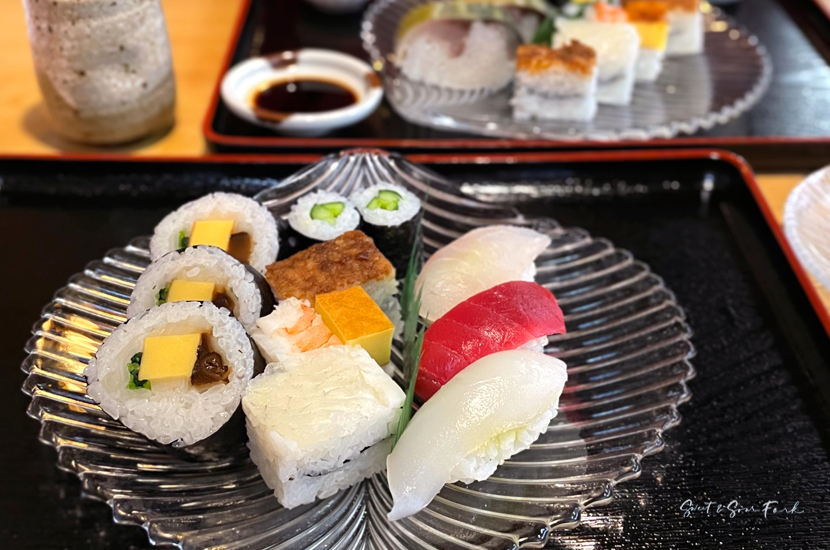
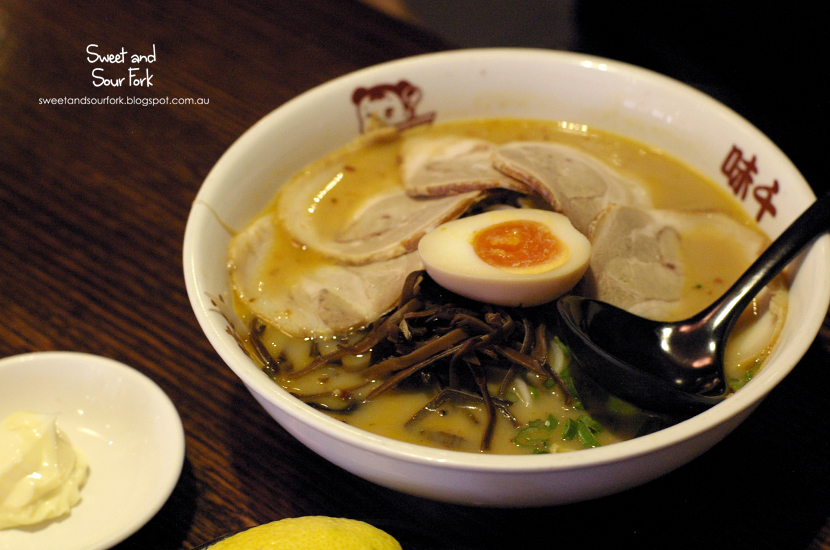


2 Comments
I like japanese food. Im going to Japan next spring. I cant wait.
Hi Claudia, that is so exciting!! Have you ever been before? The food you can get for around 1000 yen is amazing in quality, you will have a great time! Don’t forget to check out the convenience stores!